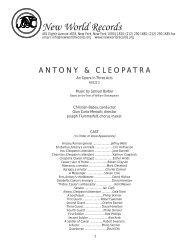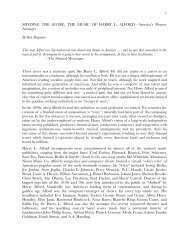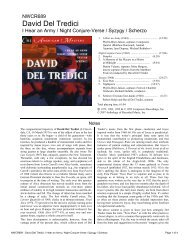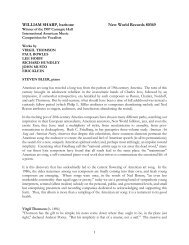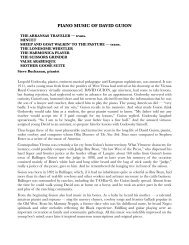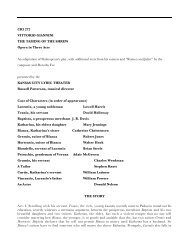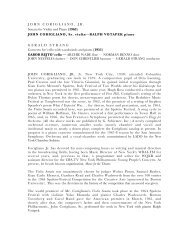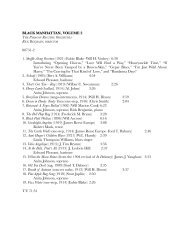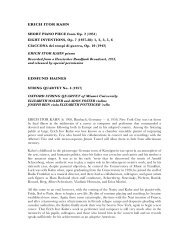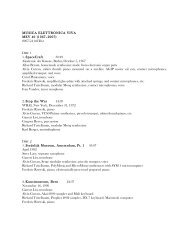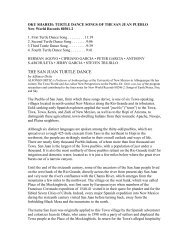CRI SD 502 George Antheil George Antheil: La Femme 100 Têtes ...
CRI SD 502 George Antheil George Antheil: La Femme 100 Têtes ...
CRI SD 502 George Antheil George Antheil: La Femme 100 Têtes ...
Create successful ePaper yourself
Turn your PDF publications into a flip-book with our unique Google optimized e-Paper software.
<strong>CRI</strong> <strong>SD</strong> <strong>502</strong><br />
<strong>George</strong> <strong>Antheil</strong><br />
<strong>George</strong> <strong>Antheil</strong>: <strong>La</strong> <strong>Femme</strong> <strong>100</strong> <strong>Têtes</strong> (1933) (40:11)<br />
David Albee, piano<br />
Notes by Charles Amirkhanian<br />
On September 20, 1933, at the Second Yaddo Festival of Contemporary Music in Saratoga<br />
Springs, New York, composer <strong>George</strong> <strong>Antheil</strong> gave the world premiere of his <strong>La</strong> <strong>Femme</strong> <strong>100</strong><br />
<strong>Têtes</strong> preludes. He had composed the music in the southern French coastal town of Cagnes-sur-<br />
Mer near Nice on the Riviera, in the Winter of 1932–33. He had lived there with his Hungarian<br />
wife, Böske, since June of 1932 on a Guggenheim Fellowship which thankfully had rescued him<br />
from the brink of financial collapse and had returned the couple to their commonly-adopted<br />
country after a brief interlude in the U.S.<br />
This unusual set of visionary etudes, inspired by <strong>La</strong> <strong>Femme</strong> <strong>100</strong> <strong>Têtes</strong>, a book of collaged<br />
etchings assembled by the surrealist painter Max Ernst from their original sources in volumes of<br />
nineteenth-century picture storybooks, and each given subtitles with hauntingly suggestive<br />
overtones, typifies <strong>Antheil</strong>’s music during what the composer himself referred to as his earlier<br />
“mechanistic” period (1922–25).<br />
In a letter written September 7, 1933, from the composer’s hometown in New Jersey to Mr.<br />
Henry Allen Moe, the longtime custodian of the Guggenheim program, <strong>Antheil</strong> refers to these<br />
preludes as “short, terse and steely”—representing “the subconscious and strange feelings of my<br />
childhood in Trenton.” (Shades of Jack Duluoz, the young protagonist in Dr. Sax, Jack<br />
Kerouac’s novel of intense autobiographical reminiscence, centered on his adolescence in<br />
industrial Lowell, Massachusetts.)<br />
By the Fall of 1933, with Hitler’s rise to power, and the end of an era of American expatriate<br />
artists living the good bohemian life abroad in France, <strong>Antheil</strong> had returned to the U.S. for good.<br />
The composition of <strong>La</strong> <strong>Femme</strong> marks the end of a decade of experimentation and initiation for<br />
young <strong>Antheil</strong> and the beginning of a period of reassessment.<br />
<strong>George</strong> <strong>Antheil</strong> was the first United States composer to enjoy a substantial European reputation.<br />
In the mid-twenties, he burst on the Paris scene with his flamboyant and aggressive piano works<br />
and for a few years between 1923 and 1928 was widely regarded as the most radical active living<br />
composer.<br />
His story is preserved in his 1945 autobiography Bad Boy of Music, reissued in 1981 by Da Capo<br />
Press. It is the most provocative and engaging composer’s autobiography yet written and<br />
certainly the most entertaining.<br />
Born on July 8, 1900, to Polish immigrant parents, <strong>Antheil</strong> started his professional life as a<br />
concert pianist, although he had composed music since childhood. His early studies with<br />
Constantine von Sternberg (a pupil of Liszt) in Philadelphia and the composer Ernest Bloch in<br />
New York City reinforced his modernistic tendencies and instincts.<br />
In 1922, <strong>Antheil</strong> was accepted as a protégé by the concert manager Martin Hanson, who gave the<br />
young performer a European tour, after which <strong>Antheil</strong> decided to stay abroad. From that time, he<br />
lived in Berlin, Paris, Vienna, and other European cities, emerging as a serious composer whose<br />
violent and percussive piano pieces (Sonata Sauvage, Jazz Sonata, Death of the Machines,
Airplane Sonata) were envied by the young Aaron Copland. “When I first went to Paris I was<br />
jealous of <strong>Antheil</strong>’s piano playing—it was so brilliant; he could demonstrate so well what he<br />
wanted to do.”<br />
According to Copland, “<strong>George</strong> had Paris by the ear.” In 1923 his first Paris concert, delivered as<br />
a curtain raiser for a performance of the Ballet Suedois, caused a general riot, due to the almost<br />
absurd obsessiveness of his use of repetition. <strong>Antheil</strong>, influenced by the Russian ostinatos in the<br />
music of Stravinsky, had carried the idea to lengths which would later be exceeded only by the<br />
repetitive music composers of the sixties—Riley, Reich, and Glass.<br />
<strong>Antheil</strong>’s years in Paris, 1923 through 1927, were tumultuously exciting. As the toast of the<br />
literary and artistic world there—not the musical one, which was dominated by the airy,<br />
charming, and anti-dramatic music of Les Six—<strong>Antheil</strong> had hobnobbed with the likes of James<br />
Joyce, Ezra Pound, Joan Miró, Pablo Picasso, Man Ray, Ford Madox Ford, Ernest Hemingway,<br />
Fernand Léger, Sylvia Beach, and countless others who held <strong>Antheil</strong> in extremely high regard.<br />
The tremendous impact in 1924, 1925, and 1926 of the clangorous Ballet Mécanique by <strong>Antheil</strong>,<br />
scored for three xylophones, eight grand pianos, one pianola, two electric doorbells, two wooden<br />
and one metal airplane propellers, tam-tam, four bass drums, and siren, climaxed a sensational<br />
ascendancy for the composer. When played properly—at full speed and imitating a giant<br />
mechanical orchestration gone mad—the work is smashing. And yet, even to this day, it rarely is<br />
played well in the U.S. One secret to its early European success in the days of limited virtuosity<br />
among percussionists: the xylophone parts—fiendishly difficult at the specified tempi—were<br />
performed by keyboard-operated instruments in Paris. None such were available when the work<br />
was performed in Carnegie Hall April 10, 1927. And the overbearing pre-concert publicity,<br />
handled by an overeager literary agent rather than a concert promoter, prejudiced the sold-out<br />
hall in advance, creating an artistic setback for <strong>Antheil</strong> which haunted him for years afterwards;<br />
in fact when <strong>Antheil</strong> wrote <strong>La</strong> <strong>Femme</strong>, he found himself quoting generously from the thematic<br />
material of the Ballet Mécanique.<br />
Upon his return to France in the early thirties, <strong>Antheil</strong> stopped by his old Paris haunts, including<br />
the bookshops of Adrienne Monnier (Les Amies des Livres) where the experimental French<br />
writers were carried, and Sylvia Beach (Shakespeare and Company) where the English language<br />
modernists were to be found. Very likely it was at Ms. Monnier’s establishment that he<br />
purchased copy number 657 of <strong>100</strong>0 of the first edition of Max Ernst’s <strong>La</strong> <strong>Femme</strong> <strong>100</strong> <strong>Têtes</strong>,<br />
published in 1929 by Editions du Carrefour with an introduction by no less than André Breton.<br />
<strong>George</strong>’s copy of the first edition is carefully inscribed in the hand of the composer, “<strong>George</strong><br />
<strong>Antheil</strong>—not to be borrowed.”<br />
<strong>Antheil</strong> always had been intensely interested in modernist painting. Having first encountered it<br />
via his friendship with Margaret Anderson and Jane Heap, publishers of the Little Review who<br />
lived in New Jersey and befriended <strong>Antheil</strong> in his pre-Europe days, the composer particularly<br />
had admired the work of de Chirico, the Cubists, the artists of de Stijl, and later the Surrealists,<br />
including Ernst himself, whom <strong>Antheil</strong> and Böske had known in Paris.<br />
And <strong>Antheil</strong> had attributed his own unconventional use of modular repetitive units in Ballet<br />
Mécanique to the influence of Cubist painting, in which prismatic distortion is the norm. “I<br />
portrayed a foot so large that the rest of the body must be imagined as extending beyond and out<br />
of the picture.”<br />
In fact, many of the aesthetic currents in the experimental arts which <strong>Antheil</strong> encountered in his<br />
Paris days—the absurd miniature Dada theatre and sound poetry pieces—the similar works by
the Futurists—the episodic and often austere simplicity of the piano music of his friend Erik<br />
Satie—no doubt validated for <strong>Antheil</strong> the kind of brutal and hard-edged quality of certain<br />
preludes in the <strong>La</strong> <strong>Femme</strong> collection.<br />
The boldness of the music, with its epigrammatic references to everything pianistic, from<br />
parodies of Hanon Études to echoes of the pianola of the Ballet Mécanique, lends the work a<br />
freshness which is startling even by today’s standards half a century later.<br />
<strong>Antheil</strong> noted in several items of correspondence that he intended to do <strong>100</strong> preludes for the<br />
Ernst book, the title of which translates roughly The Hundred Headless Woman, “<strong>100</strong>” in French<br />
being homonymous for “without” (cent; sans). In fact, there are neither <strong>100</strong> collages in the book,<br />
nor <strong>100</strong> preludes in the complete set by <strong>Antheil</strong>.<br />
Ernst’s book presents 146 collages in nine groups (chapters) with thematic imagery in each of<br />
the nine. But at best, the narrative thread is healthily disjunct, and the reader is lead further into<br />
Ernst’s “liberated world where everything is possible” (Dorothea Tanning in the introduction to<br />
the American edition).<br />
In the existing <strong>Antheil</strong> piano score, there are forty-four preludes, each with a Roman numeral,<br />
and a concluding “Percussion Dance.” <strong>Antheil</strong> notes in his correspondence with Mr. Moe that he<br />
played forty of the preludes—excerpts from the (promised) group of <strong>100</strong>—at Yaddo. It is<br />
possible that a few others were added to round out the series to forty-five at a later date, but since<br />
the holograph apparently is lost—only a copyist’s version is extant—it is difficult to determine<br />
just what is the precise history of the score. On the numerical front, perhaps the last laugh is<br />
<strong>Antheil</strong>’s. His collection is complete sans cent! <strong>Antheil</strong> does note in Bad Boy of Music that the<br />
<strong>La</strong> <strong>Femme</strong> music was choreographed by Martha Graham for her [1934 ballet] Dance in Four<br />
Parts, a solo premiered at the Guild Theatre November 11, 1934.<br />
As far as is known, the second concert performance of the entire score of <strong>La</strong> <strong>Femme</strong>, and<br />
perhaps the first of all forty-five pieces in the group, took place on November 20, 1970, when<br />
they were played by Julian White, during an all–<strong>Antheil</strong> concert sponsored by KPFA Radio at<br />
Hertz Hall on the campus of the University of California, Berkeley. A subjective selection of<br />
plates from the Ernst book were projected by artist Carol <strong>La</strong>w on that occasion during the<br />
performance.<br />
In 1976 at the Holland Festival, during which a great number of <strong>Antheil</strong> works were revived<br />
under the direction of composer-pianist-conductor Reinbert de Leeuw (some documented on<br />
Philips 6514.254 available in the U.S.), the Argentinean pianist Jorge Zulueta, a specialist in<br />
<strong>Antheil</strong>’s music, and his Grupe de Acción from Buenos Aires, presented a theatrical version of<br />
<strong>La</strong> <strong>Femme</strong> <strong>100</strong> <strong>Têtes</strong> in which the characters of Max Ernst, Böske <strong>Antheil</strong>, and <strong>George</strong> <strong>Antheil</strong><br />
were dramatized beneath projections of Ernst’s collages. A stream-of-consciousness compilation<br />
of <strong>Antheil</strong>’s music from this and other 1920s pieces such as the Airplane Sonata, formed the<br />
musical basis of that presentation. The only other known performances of the piano version have<br />
been done in several concerts since 1977 by David Albee.<br />
<strong>Antheil</strong>’s large opera, Helen Retires, his second, was premiered unsuccessfully at The Juilliard<br />
School in New York (28 February 1934). The impact of the Depression, on top of his recent<br />
relocation from Europe and the response to Helen, left <strong>Antheil</strong> searching for new directions.<br />
When Ben Hecht and Charlie MacArthur hired <strong>Antheil</strong> to do the music for their motion picture<br />
Once in a Blue Moon (1935), <strong>Antheil</strong> was launched on a series of new careers. Moving to<br />
Hollywood in 1936, he pieced together an income by writing occasional movie scores, writing
articles for Esquire, maintaining a syndicated lovelorn column, acting as a radio and newspaper<br />
war analyst, and patenting a torpedo in collaboration with actress Hedy <strong>La</strong>marr.<br />
<strong>Antheil</strong>’s music after 1940 took a turn toward classical forms, incorporating his own individual<br />
mixture of bittersweet lyricism, satirical paraphrases of military marches, American folktune<br />
quotations, and rambunctious boogie-woogie rhythms, often tempered with the metallic<br />
dissonance of his early music. <strong>Antheil</strong>’s avant-garde status was preempted by the dodecaphonists<br />
after World War II, but his faith in his neo-Romantic style was reinforced by the successes of his<br />
spiritual allies Britten, Shostakovich, and Prokofiev.<br />
Between 1939 and 1951 <strong>Antheil</strong> composed eight symphonic overtures on American themes. His<br />
large symphonic works were performed by most of the country’s major orchestras. Symphony<br />
No. 4 was introduced by Stokowski and the NBC Symphony (1944). Symphony No. 5 was<br />
premiered by Ormandy and the Philadelphia (1948), and No. 6 by Monteux and San Francisco<br />
(1949). <strong>Antheil</strong>’s ballet, Capital of the World, after a story by his old friend Hemingway, was<br />
introduced on the CBS television program Omnibus (1953).<br />
Throughout the fifties, <strong>Antheil</strong> worked tirelessly to establish himself as an opera composer. His<br />
setting of Ben Johnson’s Volpone (1953) contains magnificent, virtuosic vocal writing in a lively<br />
and appealing evening-length work. Other operas premiered subsequently were The Brothers<br />
(1954), The Wish (1955)—both to his own libretti—and Venus in Africa (Michael Dyne, 1957).<br />
In 1958, <strong>Antheil</strong> returned to New York City to compose music for the weekly CBS-TV<br />
documentary series The Twentieth Century, hosted by Walter Cronkite. He died of heart failure<br />
there on February 12, 1959.<br />
December 25, 1983<br />
Belton, Texas<br />
For further definitive information on <strong>Antheil</strong>’s music, which has not appeared on this label since<br />
<strong>CRI</strong> 103 was issued in 1955, the reader may refer to the following:<br />
Albee, David. <strong>George</strong> <strong>Antheil</strong>’s <strong>La</strong> <strong>Femme</strong> <strong>100</strong> <strong>Têtes</strong>–A Critical Study of the Preludes,<br />
University Microfilms, 1977, Ann Arbor.<br />
<strong>Antheil</strong>, <strong>George</strong>. Bad Boy of Music (new introduction by Charles Amirkhanian with photographs<br />
from the <strong>Antheil</strong> Estate collection), reissued by Da Capo Press, 1981, New York.(Pages<br />
255-286 describe Cagnes-sur-Mer.)<br />
Ernst, Max. The Headless Woman (introduction by André Breton, translated into English by<br />
Dorothea Tanning), reissued by <strong>George</strong> Braziller, 1981, New York.<br />
Pound, Ezra. <strong>Antheil</strong> and the Treatise on Harmony (new introduction by Ned Rorem), reissued<br />
by Da Capo Press, 1968, New York.<br />
Whitesitt, Linda. The Life and Music of <strong>George</strong> <strong>Antheil</strong>, UMI Reprints, 1983, Ann Arbor.<br />
The score of <strong>La</strong> <strong>Femme</strong> <strong>100</strong> <strong>Têtes</strong> (edited by David Albee) is published by <strong>Antheil</strong> Press<br />
(ASCAP), 7722 Lynn Avenue, El Cerrito, CA 94530.<br />
Composer Charles Amirkhanian has been music director of Pacifica Listener-Sponsored KPFA-<br />
FM in Berkeley since 1969.<br />
David Albee has been hailed for his “tremendous talent, a firm and vigorous technique, and a<br />
sure musical taste.” His appearances as an orchestra soloist and recitalist have taken him to major<br />
music centers throughout the United States. He has two other recordings and several articles to
his credit and has conducted extensive research in American piano music, including the works of<br />
<strong>George</strong> <strong>Antheil</strong>. He is associate professor of piano at Baylor University, Waco, Texas, and<br />
pianist of the Baylor Trio.<br />
This record was funded by a grant from Baylor University.<br />
<strong>La</strong> <strong>Femme</strong> <strong>100</strong> <strong>Têtes</strong>—<strong>Antheil</strong> Press, El Cerrito, Calif. (ASCAP)<br />
Recorded by Paul Concilio in Waco, August 1983.<br />
Recorded on a Bösendorfer Imperial Grand, courtesy of Kimball International, Jasper, Indiana.<br />
For <strong>CRI</strong>:<br />
Producer: Carter Harman<br />
℗ 1984 Composers Recordings, Inc.<br />
(Original liner notes from <strong>CRI</strong> LP jacket)



